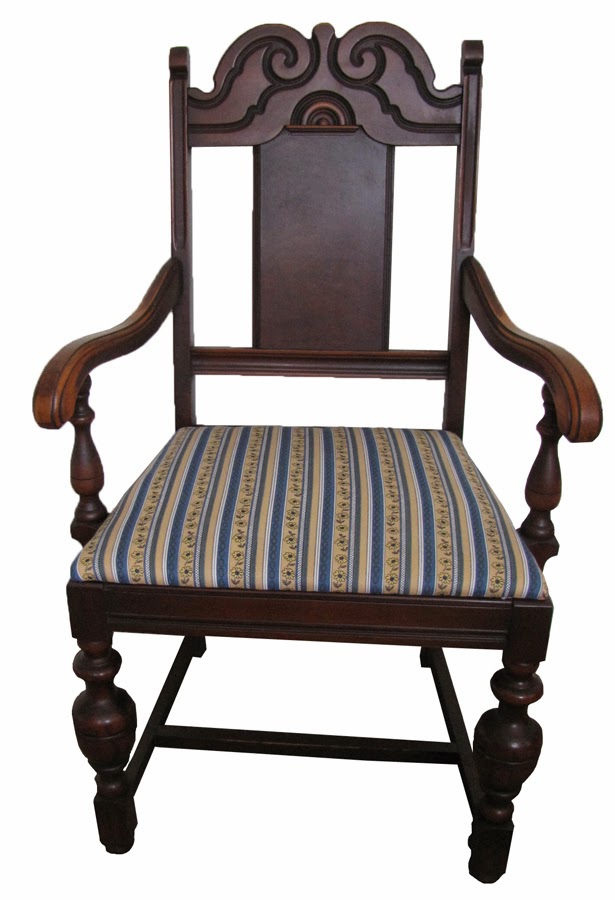 |
| Antique Chair Before |
 |
| Antique Chair After |
This was an antique chair had a lovely harp design on the back also had a heart-warming history. This chair was my customer’s husband’s grandmother’s chair and was given to the couple as a wedding present. Although grandma passed away twenty-seven years ago, the chair had been kept by family members and had been well cared for. The chair had come to us refinished, but needed new fabric, as well as spring tightening.
The previous upholsterer used inadequate material on the springs as you could see them right through the seat fabric. When I sat on the the chair, I felt as though I would fall right through, that’s how bad it was. Everything was so thin, the springs popped right through, so I got to work and stripped it all off. Once I removed the old fabric, was what revealed was; the springs had been covered with a thin layer of shabby white fabric a rusty ring outlining each spring beneath. Next was a thin layer of raw cotton and a super thin layer of foam. That was it! The common denominator was “thin.”
After I removed all the fabric, thin foam and the rest, I removed the springs. There were only four strips of webbing beneath the springs, which was inadequate. I replaced them with six strips of webbing, which I criss-crossed, making the webbing tight which lends proper support for the springs and a much better feel for the chair’s seat.
The springs were pretty rusty and greasy, so I used my grinder’s brass wheel and cleaned and polished each spring, removing the grime and rust, revealing the nice metal beneath. It made them easier to work with and of course, much nicer looking. Evening though nobody will see these newly cleaned springs, I knew they were clean and that made me happy. Having the right tools for this type of work is essential! This spring cleaning step was not necessary, but a good idea to clean the interior parts of the chair. Plus, it gives me a feeling of doing it right.
Once the springs were cleaned, I hand sewed each one into place with strong waxed upholstery thread. Each spring was marked with a black sharpie, 2 inches away from the chair’s inner frame. This is a very important step, keeping the springs in line with each other for equal support. Once this is complete, the springs receive an eight-way tie. You start with the horizontal rows and tie each spring together, secured to the chair’s frame with staples (or nails) depending on the condition of the wood. If the wood is damaged from too many nails from previous reupholstering, staples are preferable. They are my personal favorite as I feel they are much faster and easier to use. Repeat the process with vertical ties, again securing each row, looping the string around each spring to keep them tight and the same height. Once the horizontal and verticals are secured, you repeat the process, now from corner to corner, in the shape of an “X” until you have eight strings overlapping one another. I added a couple more rows on the edges of the outer springs for extra strength.
The next step is securing all the freshly tied springs with a layer of burlap, secured with staples to the edge of the chair’s frame. After the burlap, I added a 1” layer of high density foam, a thick layer of raw cotton batting, a thick layer of dacron and a layer of batting. I finished this with a layer of muslin to keep it all in place before I finished it with the fabric. After sitting on the newly finished seat, I no longer felt the springs, a good indication of a properly layered seat.
This chair was finished with decorative trim, or gimp, which was used to cover the staples that secured the fabric to the top of the chair. The back of the chair also needed to be reupholstered. The previous upholsterer used no webbing for the back, so I added a couple of strips for extra support and strength. Then I added a thin layer of closed cell foam and batting, which was appropriate for the back of the chair (unlike the seat, the needs a lot more layers of multiple materials so you don’t feel the springs.) Again, I used gimp trim to cover the staples which finished it off nicely. The gimp complemented the fabric, adding a decorative, finished look to the chair.
Check out the photos below to see the before and after springs and you can see the way an 8-way tie is properly done with chairs that have springs.
 |
Chair Before Proper
Spring Tying and Less Webbing |
 |
Chair After Proper Spring
Tying and Six Strips of Webbing |

































